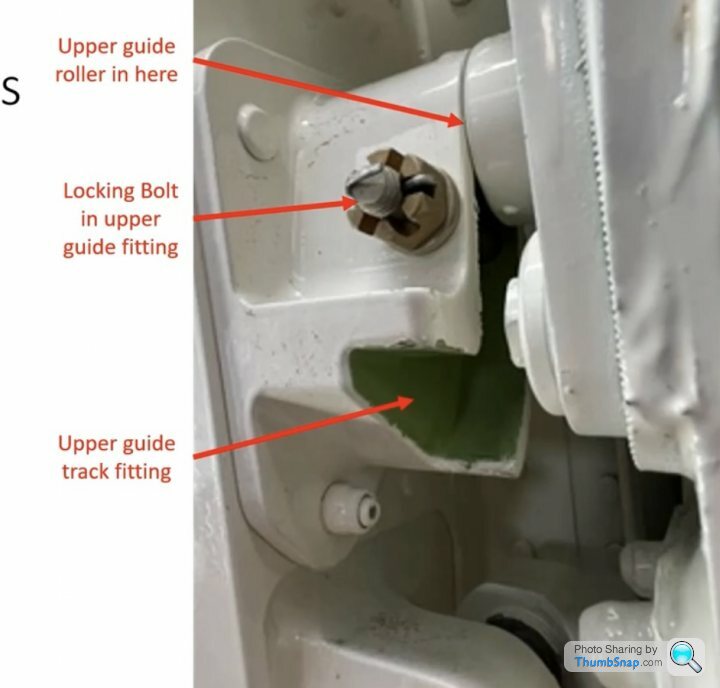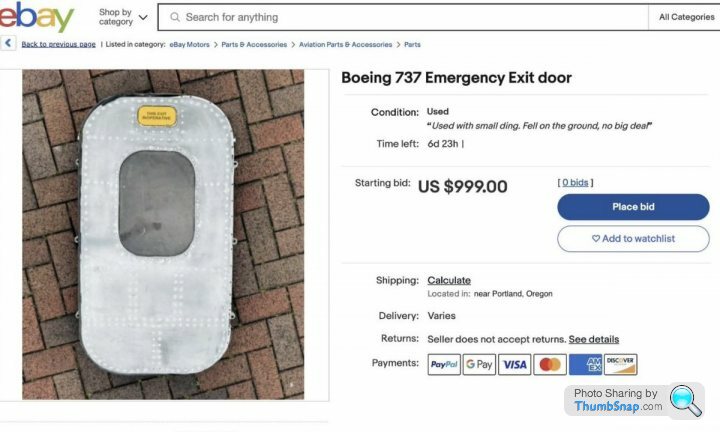Alaska Airlines grounds Boeing 737 Max 9 planes…
Discussion
hidetheelephants said:
Three of the four bolts could be missing and the plug shouldn't move, as the door mechanism is the loadbearing part.
Yes, I see that now... I read it as the bolts held the panel against the fuselage. They don't... it is held in the guide track, and as you say those bolts are just to stop it moving out of the tracks... virtually no force on the bolts at all.Panamax said:
Perhaps they were all located "finger tight" and never torqued up - something that wouldn't show on a visual inspection and wouldn't be possible to detect after the interior was installed. I've no idea whether normal inspection of bolts during aircraft construction involves an inspector walking round with a torque wrench and checking bolts.
That is not how you check torque. Putting a torque wrench in a tightened bolt will only tell you that it is tight to a minimum torque. If if is over torqued then the wrench will click. Seems there may have been some prior issues.
Alaska Airlines plane had warnings days before mid-air blowout https://www.bbc.co.uk/news/world-us-canada-6790941...
Alaska Airlines plane had warnings days before mid-air blowout https://www.bbc.co.uk/news/world-us-canada-6790941...
vaud said:
For a modern aircraft this shocks me...
"no information from the cockpit voice recorder was available, as the recording had been automatically wiped after a two-hour cut-off was reached."
It's quite a common feature on CVRs - it operates on a loop that overwrites the oldest data, much like a car dash cam. Normally of course, an air crash is over in seconds/minutes and this isnt a problem. Perhaps there should be a "save this segment" feature much like on dashcams.... "no information from the cockpit voice recorder was available, as the recording had been automatically wiped after a two-hour cut-off was reached."
Southerner said:
Panamax said:
Anyone who thinks Boeing has a poor safety record had better check their school maths book and see how the British civil aviation industry worked out.
De Havilland Comet - 114 built (including prototypes). Three disintegrated in mid air. Call it a 2.5% total failure rate.
Concorde - 20 built (including prototypes). One crashed and the rest were never financially viable. Total failure rate of 5%.
Concorde - ‘never financially viable’ in the 1960s/70s/80s/90s (didn’t it become something of a cash cow once BA revamped the service?) The one accident was attributable to something falling off of another aircraft and the airport staff not clearing the runway, no? Same aircraft flying for, what, 35 years or so with one accident not the aircraft’s fault, seems pretty safe to me.
Bit more to it with Concorde, the book by ex Concorde pilot Mike Bannister cited that the fuel tanks had been filled more than they should, so when the part of the Continental DC10 plane burst the tyre, and the debris hit the tank it ruptured.De Havilland Comet - 114 built (including prototypes). Three disintegrated in mid air. Call it a 2.5% total failure rate.
Concorde - 20 built (including prototypes). One crashed and the rest were never financially viable. Total failure rate of 5%.
Concorde - ‘never financially viable’ in the 1960s/70s/80s/90s (didn’t it become something of a cash cow once BA revamped the service?) The one accident was attributable to something falling off of another aircraft and the airport staff not clearing the runway, no? Same aircraft flying for, what, 35 years or so with one accident not the aircraft’s fault, seems pretty safe to me.
Apparently it was common practice for AF crews to overfill to give a margin, avoid refuelling and cover fuel used during taxi.
The implication being that had it not been filled beyond the limit, there would have been space within the tank to absorb the shock better and it likely wouldn't have ruptured.
Correct me if I am wrong there, was a while ago I read it !
ChemicalChaos said:
It's quite a common feature on CVRs - it operates on a loop that overwrites the oldest data, much like a car dash cam. Normally of course, an air crash is over in seconds/minutes and this isnt a problem. Perhaps there should be a "save this segment" feature much like on dashcams....
Sorry I should have said that I know it is common but that I am shocked for a brand new aircraft.J4CKO said:
Southerner said:
Panamax said:
Anyone who thinks Boeing has a poor safety record had better check their school maths book and see how the British civil aviation industry worked out.
De Havilland Comet - 114 built (including prototypes). Three disintegrated in mid air. Call it a 2.5% total failure rate.
Concorde - 20 built (including prototypes). One crashed and the rest were never financially viable. Total failure rate of 5%.
Concorde - ‘never financially viable’ in the 1960s/70s/80s/90s (didn’t it become something of a cash cow once BA revamped the service?) The one accident was attributable to something falling off of another aircraft and the airport staff not clearing the runway, no? Same aircraft flying for, what, 35 years or so with one accident not the aircraft’s fault, seems pretty safe to me.
Bit more to it with Concorde, the book by ex Concorde pilot Mike Bannister cited that the fuel tanks had been filled more than they should, so when the part of the Continental DC10 plane burst the tyre, and the debris hit the tank it ruptured.De Havilland Comet - 114 built (including prototypes). Three disintegrated in mid air. Call it a 2.5% total failure rate.
Concorde - 20 built (including prototypes). One crashed and the rest were never financially viable. Total failure rate of 5%.
Concorde - ‘never financially viable’ in the 1960s/70s/80s/90s (didn’t it become something of a cash cow once BA revamped the service?) The one accident was attributable to something falling off of another aircraft and the airport staff not clearing the runway, no? Same aircraft flying for, what, 35 years or so with one accident not the aircraft’s fault, seems pretty safe to me.
Apparently it was common practice for AF crews to overfill to give a margin, avoid refuelling and cover fuel used during taxi.
The implication being that had it not been filled beyond the limit, there would have been space within the tank to absorb the shock better and it likely wouldn't have ruptured.
Correct me if I am wrong there, was a while ago I read it !
vaud said:
ChemicalChaos said:
It's quite a common feature on CVRs - it operates on a loop that overwrites the oldest data, much like a car dash cam. Normally of course, an air crash is over in seconds/minutes and this isnt a problem. Perhaps there should be a "save this segment" feature much like on dashcams....
Sorry I should have said that I know it is common but that I am shocked for a brand new aircraft.vaud said:
For a modern aircraft this shocks me...
"no information from the cockpit voice recorder was available, as the recording had been automatically wiped after a two-hour cut-off was reached."
I was surprised at that too."no information from the cockpit voice recorder was available, as the recording had been automatically wiped after a two-hour cut-off was reached."
I assume they're digital these days so I can't see how storage should be an issue like it may have been back when it was a physical reel of tape.
Eric Mc said:
It's probably something agreed with the pilots' trade union. Flight crew don't want management listening in on flight deck conversations. It was one of the reasons why the UK was slow to install cockpit voice recorders. They only did so after the Staines Trident crash in 1972.
Given it is Boeing it's probably down to costs... United Airlines finds loose bolts on 737 Max 9 door plugs.
https://www.bbc.co.uk/news/world-us-canada-6791943...
https://www.bbc.co.uk/news/world-us-canada-6791943...
Starfighter said:
No evidence (yet) to support a blame on costs for this. Incorrect torque in the build or overhaul instructions or vibration could all be to blame. A simple wire lock could be the answer.
The bolts, if they were indeed fitted, should have had a castellated nut with a split pin by design;
Starfighter said:
Panamax said:
I've no idea whether normal inspection of bolts during aircraft construction involves an inspector walking round with a torque wrench and checking bolts.
That is not how you check torque. Putting a torque wrench in a tightened bolt will only tell you that it is tight to a minimum torque. If if is over torqued then the wrench will click. So what is the correct way to "check torque"?
Gassing Station | News, Politics & Economics | Top of Page | What's New | My Stuff




